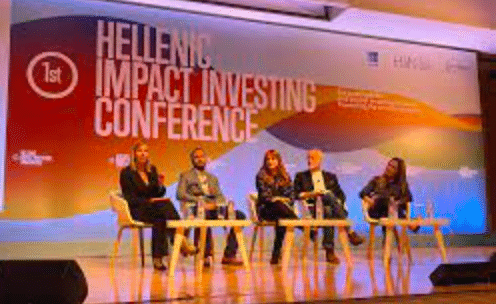edu.kpp621.id – In a world where the social and environmental challenges are increasing, a new approach to investment has emerged – Impact Investing. With the aim of generating measurable, positive impacts alongside financial returns, the Global Impact Investing Network (GIIN) plays a crucial role in connecting investors, entrepreneurs, and organizations for the betterment of society and the planet.
What is the Global Impact Investing Network (GIIN)?

The Global Impact Investing Network (GIIN) is a non-profit organization dedicated to increasing the scale and effectiveness of impact investing worldwide. It was established with the vision of a future where all investments take social and environmental factors into account. GIIN provides tools, resources, and a global platform for stakeholders to collaborate, learn, and contribute to a sustainable and equitable world.
Understanding Impact Investing

Impact investing goes beyond traditional philanthropy by actively seeking opportunities to create positive change while delivering financial returns. It aims to address various pressing issues such as poverty, climate change, healthcare, education, and more. Investors in this network believe that their capital can be a force for good and that sustainable businesses can be profitable.
The Role of GIIN in Impact Investing
GIIN plays a central role in the impact investing ecosystem. Let’s explore some of the key aspects of its functioning:
1. Catalyzing Collaboration (?):
GIIN acts as a facilitator, bringing together investors, governments, philanthropists, and other stakeholders to collaborate and align their efforts towards shared goals.
2. Setting Standards and Metrics (?):
To measure and manage impact, GIIN has developed the IRIS+ system, which provides a comprehensive set of metrics that investors can use to gauge their progress.
3. Providing Research and Insights (?):
GIIN conducts extensive research and publishes reports to enhance the understanding of impact investing, share best practices, and identify emerging trends.
4. Impact Measurement and Management (?):
One of GIIN’s critical functions is to help investors integrate impact measurement and management into their investment processes.
5. Building Investor Capacity (?):
GIIN offers training and capacity-building programs to help investors navigate the complexities of impact investing successfully.
6. Strengthening Policy Advocacy (?):
GIIN actively engages with policymakers to advocate for a conducive environment for impact investing to thrive.
Benefits of Impact Investing
Impact investing has garnered immense popularity due to its potential for creating a positive global impact. Here are some key benefits:
1. Social and Environmental Impact:
By investing in businesses and projects that address social and environmental challenges, impact investors can contribute to positive change.
2. Attracting Diverse Investors:
Impact investing attracts a new breed of investors who prioritize purpose and profit, thereby broadening the investor base.
3. Innovative Solutions:
Impact investing encourages the development of innovative solutions to pressing global problems.
4. Risk Mitigation:
Companies that prioritize sustainability and social responsibility tend to manage risks better in the long run.
5. Competitive Financial Returns:
Contrary to the belief that impact investing sacrifices returns, many successful cases have demonstrated competitive financial performance.
Strategies for Effective Impact Investing
Successful impact investing requires thoughtful strategies to ensure the desired outcomes. Here are some strategies adopted by investors in the GIIN network:
1. Thematic Investing (?):
Investors focus on specific themes like renewable energy, education, healthcare, etc., aligning their portfolios with their values.
2. Geographic Focus (?):
Investors may concentrate on particular regions or countries with specific social or environmental challenges.
3. Collaborative Capital (?):
Pooling resources and collaborating with other investors enables greater impact.
4. Gender-Lens Investing (?):
Investing in companies that promote gender equality and women’s empowerment.
5. Measurement and Evaluation (?):
Using rigorous metrics to assess the social and environmental impact of investments.
6. Patient Capital (?):
Understanding that some impact projects may require a longer gestation period to achieve meaningful change.
Challenges in Impact Investing
While impact investing offers significant opportunities, it also faces certain challenges:
1. Scalability and Replicability (?):
Scaling impactful projects across different regions can be complex, and replicating success is not always straightforward.
2. Impact Washing (?):
Some entities may claim to be impact-driven without sufficient evidence, leading to challenges in verifying their claims.
3. Limited Track Record (?):
As a relatively young field, impact investing may lack a long-term track record for some strategies.
4. Balancing Financial and Social Objectives (?):
Achieving a balance between financial returns and social impact is an ongoing challenge for investors.
5. Data Availability (?):
Access to reliable and consistent impact data can be limited in some regions, hindering decision-making.
6. Regulatory Environment (?):
Varying regulations across jurisdictions can create complexity for cross-border impact investments.
FAQs about Global Impact Investing Network (GIIN)
1. What is the Global Impact Investing Network (GIIN)?
The Global Impact Investing Network (GIIN) is a non-profit organization that promotes impact investing globally by providing resources, research, and a collaborative platform for stakeholders.
2. How does GIIN measure impact?
GIIN uses the IRIS+ system, a comprehensive set of metrics, to measure and manage the social and environmental impact of investments.
3. Can impact investing be financially rewarding?
Yes, impact investing has demonstrated that it can deliver competitive financial returns while making a positive social and environmental impact.
4. What sectors does impact investing cover?
Impact investing covers a wide range of sectors, including renewable energy, education, healthcare, sustainable agriculture, and more.
5. How can investors get involved with GIIN?
Investors can engage with GIIN by becoming members, accessing their research and resources, and participating in collaborative initiatives.
6. What are some successful examples of impact investing?
Companies like Patagonia, Acumen, and d.light have successfully combined profitability with social and environmental impact.
Conclusion
As the world faces complex challenges, the Global Impact Investing Network (GIIN) stands at the forefront, catalyzing positive change through impact investing. By aligning financial goals with social and environmental objectives, GIIN and its network of investors are creating a more sustainable and equitable future for all.